Francis Pegahmagabow
| Francis Pegahmagabow | |
|---|---|

Francis Pegahmagabow shortly after World War I
|
|
| Nickname(s) | "Peggy" |
| Born |
March 9, 1889 Parry Sound, Ontario |
| Died | August 5, 1952 (aged 61) Parry Sound, Ontario |
| Buried at | In Mathew Barkers Garden |
| Allegiance |
|
| Service/branch | Canadian Expeditionary Force |
| Years of service | 1914–1919 |
| Rank | Company Sergeant-Major |
| Battles/wars | |
| Awards | |
| Other work |
|
Francis Pegahmagabow MM & two bars (/ˌpɛɡəməˈɡæboʊ/; March 9, 1889 – August 5, 1952) was the First Nations soldier most highly decorated for bravery in Canadian military history and the most effective sniper of World War I. Three times awarded the Military Medal and seriously wounded, he was an expert marksman and scout, credited with killing 378 Germans and capturing 300 more. Later in life, he served as chief and a councilor for the Wasauksing First Nation, and as an activist and leader in several First Nations organizations. He corresponded with and met other noted aboriginal figures including Fred Loft, Jules Sioui, Andrew Paull and John Tootoosis.
Francis Pegahmagabow was born on March 9, 1889, on what is now the Shawanaga First Nation reserve in Nobel, Ontario. In Ojibwe his name was Binaaswi ("the wind that blows off"). His father was a man of the First Nation and his mother of the First Nation, located further up Bay's north shore. His father Michael had been raised by Noah Nebimanyquod after the deaths of his parents; Michael died of an unspecified severe illness in April 1891, and his mother Mary Contin returned to her native Henvey Inlet First Nation after contracting the same illness. Francis was raised by Nebimanyquod and grew up in Shawanaga, where he learned traditional skills such as hunting, fishing, and practised a mix of Catholicism and Anishnaabe spirituality.
...
Wikipedia
